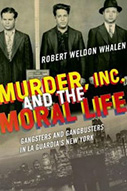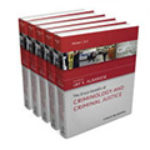MURDER, INC. and the MORAL LIFE: GANGSTER AND GANGBUSTERS IN LA GUARDIA’S NEW YORK

Author: Robert Weldon Whalen
Publisher: Bronx, NY: Fordham University Press, 2016. 288p.
Reviewer: Frederick T. Martens | January 2017
History can be and often is a sobering reflection of the past, but also an equally important and welcomed window into the present and a predictor of the future, with certain qualifications. Words can and often do paint vivid pictures, and Robert Weldon Whalen, a pre-eminent historian, has demonstrated his skill in assembling and analyzing the spoken word, not only in this book but in others he has published. And that is what makes him and this book so refreshing. Finally, we have an author and researcher who does not come from the list of “usual suspects” who have devoted their careers to researching and writing about organized crime.
Of course to some, this could as well be seen as a liability insofar as Whalen does not refer to such noted organized crime historians as Humbert Nelli, Mark Haller, and Alan Block among others. I would, however, conclude that this makes Whalen’s findings even more transparent, original and enriching. He portrays the political economy of organized crime during the so-called “Roaring Twenties,” when laws were openly violated and gangsters were perceived as “swashbuckling heroes” by some parts of the communities they literally “served.”
Irish, Jewish and Italian racketeers were quite ruthless and amoral in their use of violence and mayhem to exact retribution on those—mostly immigrants— who did not adhere to their demands. Murder, Inc. was just such an organization that instilled a reign of terror on many of the immigrant neighborhoods in the City of New York during the 1920s and 1930s.
“There were, indeed, ethnic gangs in New York…but the most striking thing about them was not simply their ethnicity but also their immigrant status. Italians and Jews had been among the leading immigrant groups around the turn of the century; Italians and Jews made up the gangsters of the 1920s and 1930 though there were still occasional Irishmen…Some gangs were ethnically homogeneous…some were ethnically ecumenical…,” Whalen asserts.
Hence, what Whalen brings us is a story about immigration, violence, corruption, and terror that in some respects could mimic much of the divisive discussions surrounding these same topics today. Clearly, he is neither shy nor reluctant to describe the horrific conditions that confronted these communities, who had little faith in the police, the judicial system and the dynasties that controlled the city’s political apparatus.
Most strikingly, Whalen’s approach to Murder, Inc. seems to dove-tail quite nicely into the later research on the political economy of organized crime in Seattle (Chambliss); in Chicago (Landesco); in Atlantic City (Duke; Nelson); in Philadelphia (Haller); and many other urban areas in the United States. It certainly adds and enriches our understanding of the critical role organized crime played (and continues to play) in the evolution of American “capitalism” and “democracy.”
When he speaks to the political corruption that permeated New York City during Mayor Jimmy Walker’s era, Whalen cites the gambling and sex industries that were protected by corrupt cops, politicians, prosecutors and judges through a system of “insurance” that was organized by the likes of Johnny Torrio and Frank Costello. “Tribute” as we know it today was either paid by the operators of these illicit industries, or they were arrested, firebombed, beaten or killed. “Criminals virtually owned the police department and the politicians…New York was the perfect market economy…everything was for sale.”
Whalen certainly addresses the organization of crime in ways that seem to have captured what has proven to be an ongoing debate for several decades: Just how structured, organized and efficient is organized crime?
Citing the iconic prosecutor Burton Turkus, who described Murder, Inc. as “a capitalist, profit-maximizing enterprise, carefully organized into multiple, heirarchally arranged levels…led by sinister men in silk suits who insisted they were just businessmen,” Whalen seems to question and refute this rather classic law enforcement description.
Instead, Whalen seems to be more supportive of Robert Lacey, who argued that these gangs were not “tidily structured, quasi-corporations….to the contrary they were fluid, constantly morphing, loose affiliations of ‘gray rats’, unconfined by structure…free to scavenge and pursue profit as opportunity and their aptitude led them.”
Accordingly, Whalen concluded that groups like the Brownsville gang were “shape-shifting, Kaleidoscopic, often temporary alliances among people who acted as often on impulse as according to plan…the hierarchies were fluid.” Nonetheless, this “post modern quality…made them extraordinarily difficult to eradicate…Remove a leader and another pops up; fracture this gang, and its pieces reconfigure into other gangs; squeeze off their source of income, and the gang finds another.”
Interestingly, Whalen does not speak at all about Cosa Nostra and makes only a fleeting reference to Mafia—in a way that suggests it was more than just a monolithic organization, but rather a way of life in the Italian immigrant community.
Thomas Dewey, the crusading reform-minded district attorney who ultimately went on to be the Governor of New York referred to “the Mafia” as being “worse than the rest of the underworld. There was no honor among this breed of thieves, gunmen, robbers, narcotics peddlers, pimps, murders, and racketeers. They were slimy, cheating savages.”
Dewey prosecuted Charles “Lucky” Luciano for running the prostitution rackets in New York City, but ultimately released him from prison on the promise that he would return to Italy. This event has been the subject of speculation and conjecture over the years, some of which questioned Dewey’s ethics and integrity. Whalen leaves the question open, but suggests that Dewey’s release of Luciano was to “remove an injustice” he, Dewey may have perpetrated; a moral position that was more consistent with the philosopher Amartya Sen than John Rawls (who envisioned justice as “fairness”), Whalen argues.
Contrasting Dewey’s belief in a government of laws—although we know very little about whether Dewey was as ethical as he righteously portended—Whalen cites Fiorello LaGuardia: “When six gangsters meet six policemen and the gangsters get mussed up, it’s just too bad for them. We have no room in the Police Department for sissies.” And echoing LaGuardia, Police Commissioner Lewis Valentine stated, “men [like Pittsburg Phil Strauss] should be mussed up. Blood should be smeared all over his velvet collar.” The end clearly justified the means, and as Whalen points out, “In LaGuardia, the lambs, victims, losers, deceived, and rabble had found their champion.”
Dewey, on the other hand, believed that “civic discourse is central to justice…justice is concerned fundamentally with public debates about the right thing to do on earth, not on what is perfectly right in the heavens…We find out whether Waxey Gordon and Lucky Luciano are guilty by asking twelve different jurors to ask themselves, is Justice to be effective in this country, in the courts, or is it not?”
It is this type of basic discourse that Whalen’s employs to gain insight and perspective into the thinking of the “gang-busters” and the “gangsters.” The ethos of Murder, Inc. was a “culture of death…because it had commoditized murder…everything is a thing…everything is a commodity and every commodity is for sale…This principle fundamentally degrades persons and equally degrades democracy’s higher goods; democracy and the total market are incompatible.”
This brings me to what I believe represents the single-most troubling criticism of Whalen’s brilliant historical analysis. Integrating the rarefied world of philosophy into the historical anecdotes that Whalen so meticulously presented is certainly a unique challenge, but a risky one too. Attempting to understand and interpret the aberrant, anti-social, unethical, and criminal behavior of both the “gangsters” and “gang-busters” through a philosophical lens seems to detract from the historical picture that his words and research have meticulously painted. Indeed, in reading this exceptional piece of research, I got the uneasy feeling that Whalen was struggling to “shoe-horn” nuanced and arcane notions of justice and injustice; ethical and unethical; and morality and immorality into a treatise that sought to explain “Dutch Schultz and Lucky Luciano” through the eyes of “Hannah Arendt and Emmanuel Levinas” [his words, not mine]. I am not sure he succeeded, but it is certainly a very creative, intellectually-penetrating, and pioneering endeavor.
These observations notwithstanding, for the student of organized crime, for the student of criminology, and for the student of political sociology, this book is a must. Not only will it provide you with a powerful and thoughtful critique of crony politics during the turn of the 20th century, it will allow you to decide whether the purely criminal and predatory behavior of both “gangsters” and “gang-busters” can be appropriately reduced to the philosophical abstractions that Whalen brings to the discussion.
Immigration, terror, crime, corruption and violence are all issues that we continue to struggle with today. For as the late James Baldwin so eloquently put it, “….history is not merely something to be read…and it does not merely refer to the past…On the contrary, history is literally present in all we do…” Whalen’s brilliant contribution will demonstrate just how relevant the past is today!
Frederick T. Martens, Former President of IASOC; Former Adjunct Faculty, The College of New Jersey and Penn State University. President, Complex Litigation Sciences, LLC.


